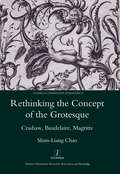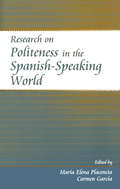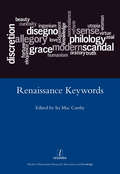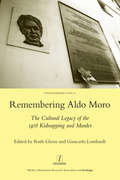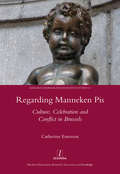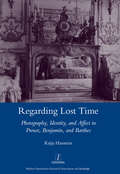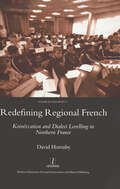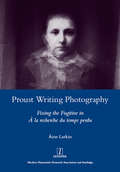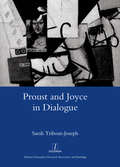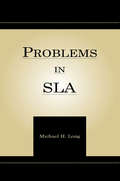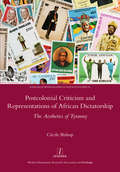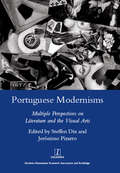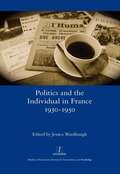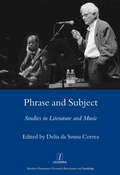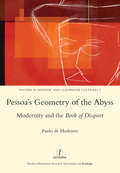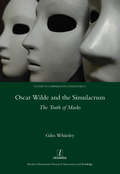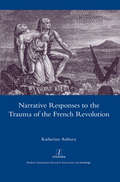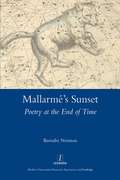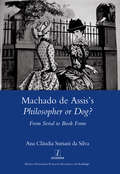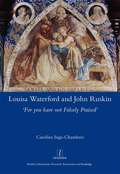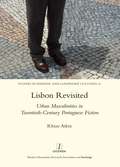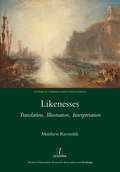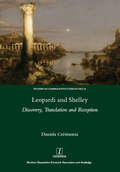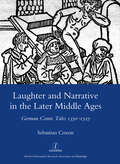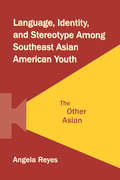- Table View
- List View
Rethinking the Concept of the Grotesque: Crashaw, Baudelaire, Magritte
by Shun-Liang ChaoHow are we to define what is grotesque, in art or literature? Since the Renaissance the term has been used for anything from the fantastic to the monstrous, and been associated with many artistic genres, from the Gothic to the danse macabre. Shun-Liang Chao's new study adopts a rigorous approach by establishing contradictory physicality and the notion of metaphor as two keys to the construction of a clear identity of the grotesque. With this approach, Chao explores the imagery of Richard Crashaw, Charles Baudelaire, and Rene Magritte as individual exemplars of the grotesque in the Baroque, Romantic, and Surrealist ages, in order to suggest a lineage of this curious aesthetic and to cast light on the functions of the visual and of the verbal in evoking it.
Research on Politeness in the Spanish-Speaking World
by María Elena Placencia Carmen GarcíaOne of the main contributions of this important book is that it offers a thorough survey of the theoretical and empirical developments that have occurred in the area of (im)politeness in the different regions of the Spanish-speaking world, gathering together overviews by distinguished scholars. Additionally, the book advances the field with new empirical research on linguistic (im)politeness, and silence and (im)politeness, in a range of (non)institutional contexts, as well as new perspectives for the study of (im)politeness. A closing chapter by the editors provides an assessment of salient trends in the area and directions for future research.Research on Politeness in the Spanish-Speaking World is essential reading for students in Spanish pragmatics and Spanish linguistics, sociolinguistics, and discourse analysis. The volume is also very useful to English-speaking scholars in the general field of pragmatics who are not proficient in Spanish but require access to these empirical studies.
Renaissance Keywords
by ItaMac CarthyCertain words played a crucial role in the making of the European Renaissance, and still recur today in our shifting understanding of it. Discretion and grace, to take two examples studied here, express how individuals thought about themselves, each other and their experience of the world, yet they are as hard to define as they are ever-present in Renaissance discourse. In this collection of essays, scholars from across the Humanities offer new interpretations of these and other 'keywords', to adopt Raymond Williams's term, and investigate the vocabulary that not only accompanied, but also produced, the cultural transformations that made the Renaissance so distinctive. A keywords approach to Renaissance Europe provides a rich contextual framework for the exploration of its central ideas. It also highlights the need for fresh thinking on current histories of the age. Seven Renaissance Keywords engages with the ongoing debate about the term 'Renaissance' itself, perhaps more our keyword than theirs, and seeks alternative ways to understand a culture and society which produced conceptions of the self as much as it did art and science. The result is an exploration at the cutting edge of contemporary research. Ita Mac Carthy is Lecturer in Italian Studies at the University of Birmingham.
Remembering Aldo Moro: The Cultural Legacy of the 1978 Kidnapping and Murder
by Ruth GlynnThe 1978 kidnapping and murder of Christian Democrat politician, Aldo Moro, marked the watershed of Italy's experience of political violence in the period known as the 'years of lead' (1969-c.1983). This uniquely interdisciplinary volume explores the evolving legacy of Moro's death in the Italian cultural imaginary, from the late 1970s to the present. Bringing a wide range of critical perspectives to bear, interventions by experts in the fields of political science, social anthropology, philosophy, and cultural critique elicit new understandings of the events of 1978 and explain their significance and relevance to present-day Italian culture and society.
Regarding Manneken Pis: Culture, Celebration and Conflict in Brussels
by Catherine EmersonManneken Pis, a fountain featuring a bronze child urinating, has stood on the same Brussels street corner since at least the mid-fifteenth century. Since there is no consensus on its meaning, it has been used to express many different readings of social relations in a complex city and nation state. It has formed part of the festival culture of the city - from royal entries to gay pride - but has also been exploited in conflicts arising out of war and occupation, and the tensions inherent in modern Belgium. Drawing on archives, histories, police reports, devotional literature, ephemera and a wealth of other sources, Catherine Emerson examines how one smaller-than-lifesized water source has come to embody a certain sort of Brussels identity.
Regarding Lost Time: Photography, Identity and Affect in Proust, Benjamin, and Barthes
by Katja HausteinWhat is autobiography and how does it transform in the age of technological reproducibility? Katja Haustein discusses this question as it relates to photography and the role of emotion in Marcel Proust's In Search of Lost Time (1909-22), Walter Benjamin's Berlin Childhood around 1900 (1932-38), and Roland Barthes's Roland Barthes (1977) and Camera Lucida (1980). In her close critical readings, Haustein provides the first comprehensive comparative analysis of these popular works, mapping them against little-studied textual, visual and aural material, some of which has only recently become accessible. In this way, her book opens new avenues in scholarship dedicated to three outstanding twentieth-century writers and contributes to a field of critical inquiry that is still in the making: the history of autobiography in the light of a history of the gaze.
Redefining Regional French
by David HornsbyThis study challenges the orthodox view that emergent regional varieties of French represent no more than an ephemeral dialect residue of little theoretical interest. It follows the life cycle of an obsolescent urban Picard variety, spoken in a mining town in the Pas-de-Calais, and attempts to unravel the complex reasons behind the survival of some local variants at the expense of others. Applying a sociolinguistic model developed by Peter Trudgill, it shows how the processes of levelling and simplification have driven change in a dialect contact situation, giving rise to a new, stable variety or koine. This is compared with other new urban varieties in Sweden and the UK, where different economic, social and demographic conditions have produced very different linguistic outcomes. The emergence of Regional French in the north, it is argued, may herald the start of a new diversification of French in Europe. This book will therefore interest both students of French and of language variation more generally.
Proust Writing Photography: Fixing the Fugitive in A La Recherche Du Temps Perdu
by Aine LarkinThe importance of vision and visual arts such as painting, theatre, and sculpture in Marcel Proust's A la recherche du temps perdu has long been affirmed; another significant system of visual representation in the novel is photography. Proust appropriated photography as a practice with its own distinctive characteristics which could inform his writing about the processes of perception and memory. Through close textual analysis of scenes where photography is experienced or observed as a practice, and scenes where photography is written into the body of the text, Aine Larkin offers an invigorating new study that sheds genuinely new light on the presence of photographic motifs in Proust's novel, and the subtlety of Proust's engagement with this modern imaging system in his work.
Proust and Joyce in Dialogue
by Sarah Tribout-JosephIt might reasonably be asked what the connection is between Francoises malapropisms in Proust and the erudite allusions of Stephens interior monologue in Joyce. Tribout-Joseph argues that they are indeed interrelated. Proust and Joyce are exemplary of Modernisms reconciliation of high literature with popular voices. Both writers explore the process of incorporation, the interface between speech and narrative. Fragments of discourse are taken from diverse sources and reoriented within new contexts. Proposed here are interconnected close readings of socio-political debate, body talk, listening processes, silences, intertextual echoes, cliche, register, conflated voices, chatter, gossip, eavesdropping, internalized debate, and misunderstandings which allow for a new configuration of the authors to emerge.
Problems in Second Language Acquisition (Second Language Acquisition Research Series)
by Michael H. LongSecond language acquisition has an identity problem. It is a young field struggling to emerge from the parent fields of education and applied linguistics. In his new book, Problems in Second Language Acquisition, Mike Long proposes a way to help second language acquisition develop a systematic and coherent focus using the philosophy of science as the lens.The volume is neatly organized into three parts--theory, research, and practice. This structure allows a focus on areas of SLA of interest to many in the field. These include theory proliferation and comparative theory evaluation; the Critical Period Hypothesis and negative feedback; and the practice of “synthetic” language teaching.The controversial volume will be of interest to researchers, educators, and graduate students in second language acquisition, applied linguistics, TESOL, and linguistics programs. It may be recommended as additional reading for an introductory SLA course in order to stimulate class discussions.
Postcolonial Criticism and Representations of African Dictatorship: The Aesthetics of Tyranny
by Cecile BishopThe figure of the dictator looms large in representations of postcolonial Africa. Since the late 1970s, writers, film-makers and theorists have sought to represent the realities of dictatorship without endorsing the colonialist cliches portraying Africans as incapable of self-government. Against the heavily-politicized responses provoked by this dilemma, Bishop argues for a form of criticism that places the complexity of the reader's or spectator's experiences at the heart of its investigations. Ranging across literature, film and political theory, this study calls for a reengagement with notions - often seen as unwelcome diversions from political questions - such as referentiality, genre and aesthetics. But rather than pit 'political' approaches against formal and aesthetic procedures, the author presents new insights into the interplay of the political and the aesthetic. Cecile Bishop is a Junior Research Fellow in French at Somerville College, Oxford.
Portuguese Modernisms: Multiple Perspectives in Literature and the Visual Arts
by Steffen DixFor a more encompassing and stimulating picture of Modernism seen as a movement of the 20th century, a broad spectrum of work across many countries we must explore its diversity. Portuguese Modernism manifested itself both in visual art and in literature, and made a vigorous contribution to this time of profound cultural change. Indeed, the sociocultural transformations that marked the early 20th century in Portugal are still current. This volume provides a critical guide for students and teachers, contributed by an array of scholars with unparalleled knowledge of the period, its artists and its writers. Steffen Dix is Research Fellow at the Institute of Social Science, University of Lisbon; Jeronimo Pizarro is Research Fellow at the Linguistics Centre, University of Lisbon.
Politics and the Individual in France 1930-1950
by Jessica WardhaughThe crises and conflicts of mid-century Europe highlight the fragility of individual life and commitment. Yet this was a time at which individuals engaged in politics on an unprecedented scale, whether in movements, parties and street politics, through culture, or by the choices confronted in war and occupation. Focusing on France, and bringing together historians of politics, literature, philosophy, art, and film, this volume sheds new light on the imagination and experience of the political individual in the age of the masses. From a controversial art exhibition on Algeria to the private diary of a Jewish lawyer in Occupied Paris, these case studies illuminate the specificities of French ideas and experiences in mid-century Europe. They also contribute to a deeper understanding of memory, agency, and responsibility in times of crisis.
Phrase and Subject: Studies in Music and Literature
by DeliadaSousa CorreaThe confluence between music and literature, long hymned as sister arts, is a newly burgeoning field of critical inquiry. This innovative collection of interdisciplinary essays provides a valuable introduction to the field, mapping the contours of recent research and investigating the mutual aesthetic influence of the two arts and their common historical ground. The examination of literary works using music as an analogy for literary composition and agent of cultural value, and the consideration of musical works whose structure is derived from literary models will excite the interest of both professional scholars and students in the fields of musicology, literary studies and modern European languages. (Legenda 2006) Delia da Sousa Correa is Lecturer in Literature at The Open University. She is the author of George Eliot, Music and Victorian Culture (2002) and editor of
Pessoa's Geometry of the Abyss: Modernity and the Book of Disquiet
by PauloDe Medeiros"Fernando Pessoa wrote prolifically in many genres until his untimely death in 1935, and he has long been widely recognized as Portugal's most influential twentieth century writer. The publication of the Book of Disquiet in 1982, however, caused a seismic change in the appreciation of his work and its place in Modernism. In that great and vast collection of fragments, Pessoa firmly established his place among the canon of European modernists and radically questioned many of Modernity's assumptions. Alain Badiou, for example, has argued that philosophers are not yet able to assimilate Pessoa's thinking. Paulo de Medeiros's new study, one of the first to be dedicated to the Book of Disquiet, takes up that challenge, exploring the text's connections with photography, film, politics and textuality itself, and developing comparisons with D. H. Lawrence, Walter Benjamin, and Franz Kafka. Paulo de Medeiros is Professor of Modern and Contemporary World Literatures in the Department of English and Comparative Literary Studies at the University of Warwick."
Oscar Wilde and the Simulacrum: The Truth of Masks
by Giles WhiteleyOscar Wilde is more than a name, more than an author. From precocious Oxford undergraduate to cause celebre of the West End of the 1890s, to infamous criminal, the proper name Wilde has become an event in the history of literature and culture. Taking Wilde seriously as a philosopher in his own right, Whiteley's groundbreaking book places his texts into their philosophical context in order to show how Wilde broke from his peers, and in particular from idealism, and challenges recent neo-historicist readings of Wilde which seem content to limit his irruptive power. Using the paradoxical concept of the simulacrum to resituate Wilde's work in relation to both his precursors and his contemporaries, Whiteley's study reads Wilde through Deleuze and postmodern philosophical commentary on the simulacrum. In a series of striking juxtapositions, Whiteley challenges us to rethink both Oscar Wilde's aesthetics and his philosophy, to take seriously both the man and the mask. His philosophy of masks is revealed to figure a truth of a different kind - the simulacra through which Wilde begins to develop and formulate a mature philosophy that constitutes an ethics of joy.
Narrative Responses to the Trauma of the French Revolution
by Katherine AstburyDuring the French Revolution, traditional literary forms such as the sentimental novel and the moral tale dominate literary production. At first glance, it might seem that these texts are unaffected by the upheavals in France; in fact they reveal not only a surprising engagement with politics but also an internalised emotional response to the turbulence of the period. In this innovative and wide-ranging study, Katherine Astbury uses trauma theory as a way of exploring the apparent contradiction between the proliferation of non-political literary texts and the events of the Revolution. Through the narratives of established bestselling literary figures of the Ancien Regime (primarily Marmontel, Madame de Genlis and Florian), and the early works of first generation Romantics Madame de Stael and Chateaubriand, she traces how the Revolution shapes their writing, providing an intriguing new angle on cultural production of the 1790s.Katherine Astbury is Senior Lecturer in French Studies at the University of Warwick.
Mallarme's Sunset: Poetry at the End of Time
by Barnaby NormanThe writings of the great Symbolist poet Stephane Mallarme (1842-1898) were to become uniquely influential in twentieth century literary criticism. For critics and philosophers such as Maurice Blanchot and Jacques Derrida, Mallarme's name came to represent a rupture in literary history, and an opening of literature onto a radically new kind of writing. Through close readings of key works, Norman retraces Mallarme's trajectory as a poet, showing in particular how he positioned his work in relation to Hegel's Aesthetics. Analysing the motif of the sunset Norman argues that Mallarme situated his work at the conclusion of the history of art, in Hegelian terms, and it is this that made him so interesting for Blanchot and Derrida. Their readings, born of their wish to subvert Hegel's totalizing impulse, give rise to an entirely new view of works now almost universally seen as masterpieces.
Machado De Assis's Philosopher or Dog?: From Serial to Book Form
by Surianida SilvaThe great Brazilian writer Joaquim Maria Machado de Assis (1839-1908) published five of his nine novels as feuilletons in daily newspapers or fortnightly women's magazines. How were the structure and themes of those novels entangled with this serial-publication form? In da Silva's important new study, textual scholarship, critical theory and the history of the book are combined in order to trace this relationship. The most important case study is an extended consideration of Philosopher or Dog? (1891), the novel after which he abandoned the feuilleton. Through a comparison of the serial and book versions of Philosopher or Dog? and a thorough study of the periodical in which it appeared, the international women's magazine The Season , da Silva analyses the changes which the genre novel was undergoing at the end of the nineteenth century: the decline of the serial, and the standardisation of female press. Ana Claudia Suriani da Silva is Tutor of Portuguese at the University of Birmingham and Honorary Research Fellow at Birkbeck College, University of London.
Louisa Waterford and John Ruskin: 'For You Have Not Falsely Praised'
by Caroline Ings-ChambersLouisa Waterford (1818-91), modest, retiring, of good family, renowned for her beauty, and with extraordinary grace, was the embodiment of a Victorian ideal of womanhood. But like the age itself, her life was filled with contrasts and paradoxes. She had been born with artistic gifts, and became a satellite of the Pre-Raphaelite Brotherhood, though she had no formal training. Then, at the height of John Ruskin's intellectual power and success as a critic, she asked him to accept her as an art student, and he accepted. Their correspondence- often harshly critical, never, as Waterford put it, falsely praising - lies at the heart of this book. These are letters which open a spectrum of discussion on the cultural, gender and social issues of the period. Both Waterford and Ruskin engaged in tireless philanthropic work for diverse causes, crossing social boundaries with subtle determination, and both responded to a sense of duty as well as an artistic vocation. But, as Ings-Chambers shows, their correspondence was more than a dialogue about society: it helped to make Waterford the artist she became.
Lisbon Revisited: Urban Masculinities in Twentieth-Century Portuguese Fiction
by Rhian AtkinTwentieth-century Portugal saw dramatic political and social change. The monarchy was abolished, and a republic installed (1910), soon giving way to a long-lasting dictatorship (1926); a transition to democracy (1974) led to membership of the European Union (1986). But what do we know of how people lived during these periods? And how did men, in particular, respond to the changes taking place in society? In this illuminating and broad-ranging study, Rhian Atkin uses as case studies the work of Fernando Pessoa (1888-1935), Luis de Sttau Monteiro (1926-93) and Jose Saramago (1922-2010) in order to examine the relationship between socio-political change and the construction and performance of masculinities in the urban environment of Lisbon over the course of the last century.
Likenesses: Translation, Illustration, Interpretation
by Matthew ReynoldsTranslation, illustration and interpretation have at least two things in common. They all begin when sense is made in the act of reading: that is where illustrative images and explanatory words begin to form. And they all ask to be understood in relation to the works from which they have arisen: reading them is a matter of reading readings. Likenesses explores this palimpsestic realm, with examples from Dante to the contemporary sculptor Rachel Whiteread. The complexities that emerge are different from Empsonian ambiguity or de Man's unknowable infinity of signification: here, meaning dawns and fades as the hologrammic text is filled out and flattened by successive encounters. Since all literature and art is palimpsestic to some degree - Reynolds proposes - this style of interpretation can become a tactic for criticism in general. Critics need both to indulge and to distrust the metamorphic power of their interpreting imaginations. Likenesses follows on from the argument of Reynolds's The Poetry of Translation (2011), extending it through other translations and beyond them into a wide range of layered texts. Browning emerges as a key figure because his poems laminate languages, places, times and modes of utterance with such compelling energy. There are also substantial, innovative accounts of Dryden, Stubbs, Goya, Turner, Tennyson, Ungaretti and many more.
Leopardi and Shelley: Discovery, Translation and Reception
by Cerimonia DanielaGiacomo Leopardi (1798-1837) and Percy Bysshe Shelley (1792-1822) crossed paths during their lifetimes, and though they never met, the legacy of their work betrays a shared destiny. As prominent figures who challenged and contributed to the Romantic debate, Leopardi and Shelley hold important roles in the history of their respective national literatures, but paradoxically experienced a controversial and delayed reception outside their native lands. Cerimonia�s wide-ranging study brings together these two poets for the first time for an exploration of their afterlives, through a close reading of hitherto unstudied translations. This intriguing journey tells the story, from its origins, of the two poets� critical fortune, and examines their position in the cultural debates of the nineteenth century; in disputes regarding translation theories and practices; and shows the configuration of their identities as we understand their legacy today.
Laughter and Narrative in the Later Middle Ages: German Comic Tales C.1350-1525
by Sebastian CoxonIn contrast to the vernacular literary traditions of France, Italy and England, comic tales in verse flourished in late medieval Germany, providing bawdy entertainment for larger audiences of public recitals as well as for smaller numbers of individual readers. In a sustained close analysis Sebastian Coxon explores both the narrative design and fundamental thematic preoccupations of these short texts. A distinctively performative tradition of pre-modern narrative literature emerges which invited its recipients to think, learn and above all to laugh in a number of different ways.
Language, Identity, and Stereotype Among Southeast Asian American Youth: The Other Asian
by Angela ReyesThis book—an ethnographic and discourse analytic study of an after-school video-making project for 1.5- and second-generation Southeast Asian American teenagers—explores the relationships among stereotype, identity, and ethnicity that emerge in this informal educational setting. Working from a unique theoretical foundation that combines linguistic anthropology, Asian American studies, and education, and using rigorous linguistic anthropological tools to closely examine video- and audio- recorded interactions gathered during the video-making project (in which teen participants learned the skills for creating their own video and adult staff learned to respect and value the local knowledge of youth), the author builds a compelling link between micro-level uses of language and macro-level discourses of identity, race, ethnicity, and culture. In this study of the ways in which teens draw on and play with circulating stereotypes of the self and the other, Reyes uniquely illustrates how individuals can reappropriate stereotypes of their ethnic group as a resource to position themselves and others in interactionally meaningful ways, to accomplish new social actions, and to assign new meanings to stereotypes. This is an important book for academics and students in sociolinguistics, linguistic anthropology, discourse analysis, and applied linguistics with an interest in issues of youth, race, and ethnicity, and/or educational settings, and will also be of interest to readers in the fields of education, Asian American studies, social psychology, and sociology.
